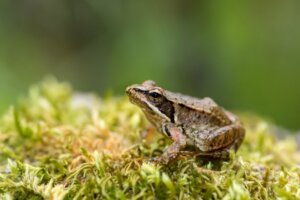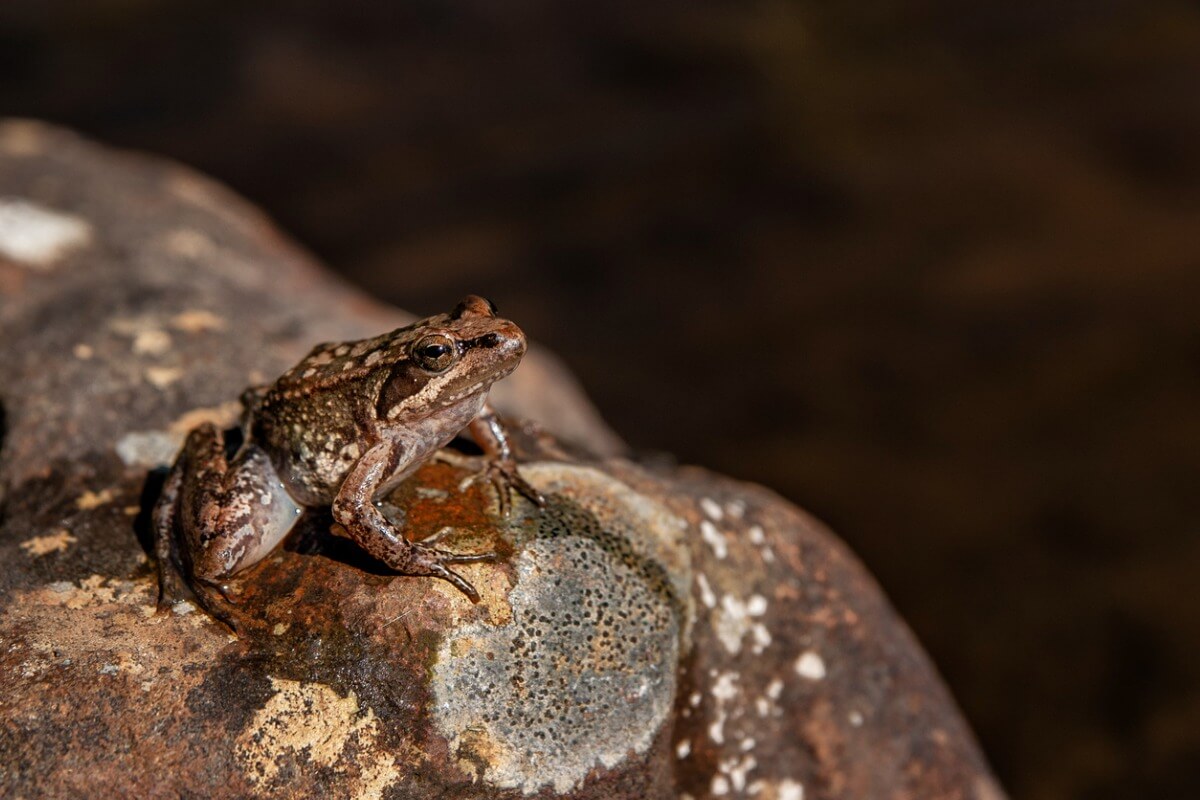Iberian Frog: Habitat and Characteristics


Written and verified by the biologist Cesar Paul Gonzalez Gonzalez
The Iberian frog inhabits mountainous regions with crystal clear watercourses. It’s quite small and has suffered many problems due to the introduction of invasive species. For this reason, its population was on the verge of disappearing, but thanks to the efforts of several researchers it still persists in its struggle to survive.
The scientific name of this species is Rana iberica and it belongs to the Ranidae family. It’s part of the “true frogs” group, although the term has no taxonomic meaning. Continue reading this article and learn a little more about this beautiful European specimen.
Habitat and distribution of the Iberian frog
The Iberian frog is endemic to the Iberian Peninsula and is distributed occasionally in Portugal, Galicia, Basque Country, Leon, Zamora, and Asturias. It’s characterized by being an almost entirely aquatic species, so it isn’t usually seen far from water. Its habitat consists of cold water streams, crystal clear ponds, and high mountain lagoons.
This beautiful amphibian can live in different altitudinal ranges, from sea level to 2425 meters (7950 feet) above sea level. It withstands low temperatures well and has even been seen surviving in glacial lakes. Of course, it needs a habitat with abundant vegetation and shady areas that allow it to have the necessary humidity to carry out gaseous exchanges through the skin.

Characteristics of the Iberian frog
The species measures about 5 centimeters (2 inches) in length, but females can reach 7 centimeters (nearly 3 inches). Two lateral ridges project from its nose, passing around the contour of its eyes and ending at the groin. In addition, it exhibits some granules on its back and on the back of its legs.
The body of this amphibian has a brownish coloration that combines other shades such as yellow, red, and gray. It has a pattern of yellow spots distributed all over its back, while its belly is pale with some black markings. Despite this, there are certain differences in its appearance depending on the geographical area it’s found in.
Behavior
The coloration of the Iberian frog provides it with mimetic protection, as it allows it to go unnoticed by simply remaining motionless. This serves it well on the stream bottom as well as on the land surface. In case a predator detects it, all it does is jump into the water. For this reason, it doesn’t usually stray far from aquatic bodies.
These amphibians have an amazing ability to react to predators, as they have even been seen to change features of their life cycle in order to survive. According to a study published in the journal Biological Invasions. The tadpoles of the Iberian frog metamorphose earlier to avoid becoming food for their enemies.
Feeding
This species is active both during the day and at night, so it takes advantage of this to have a very diverse diet. The most commonly consumed prey are flies, beetles, spiders, and frigate birds, although there are other arthropods that are also part of its menu. In other words, it is a small vertebrate that is mostly insectivorous.
Life cycle and reproduction
The amphibian life cycle is characterized by three phases: egg, larva (tadpole), and adult. The tadpole is distinguished by its fish-like morphology and its complete dependence on water. Before reaching maturity, it undergoes a metamorphosis that drastically changes its body and transforms it into an adult. It’s only at this moment that the specimen is able to get out of the water.
Adult Iberian frogs are oviparous with external fertilization. This means that they lay eggs, but the female and male release their gametes into the water at the same time to fertilize them. In the case of the long-legged frog, the mating season is between March and May or November and March (depending on the area).
Tadpoles hatch from eggs about three months after laying. They are herbivores and feed on plant debris floating on the water. They begin their metamorphosis at three months of age, but will be able to reproduce at two years of age.
Conservation status
According to the International Union for Conservation of Nature, the Iberian frog is a vulnerable species. This is mainly due to urbanization, habitat loss, and the introduction of invasive species into its ecosystem. Being highly dependent on water bodies, any change in the quality or size of the watercourse affects its population too much.
As if that weren’t enough, settlers near its habitat have encouraged the introduction of brook trout for consumption. This organism is a voracious predator that feeds on the tadpoles of the Iberian frog. Due to this situation, their populations decreased drastically, although the process was stopped thanks to strategies to eradicate invasive fish species.
Efforts to save the species seem to be bearing fruit and populations are improving. However, there’s still a lot of work ahead to ensure that it doesn’t disappear completely. Incredible as it may sound, the loss of one species is enough to upset the balance of the whole ecosystem. Every living thing counts and we can’t afford to lose them without trying to do something about it.
The Iberian frog inhabits mountainous regions with crystal clear watercourses. It’s quite small and has suffered many problems due to the introduction of invasive species. For this reason, its population was on the verge of disappearing, but thanks to the efforts of several researchers it still persists in its struggle to survive.
The scientific name of this species is Rana iberica and it belongs to the Ranidae family. It’s part of the “true frogs” group, although the term has no taxonomic meaning. Continue reading this article and learn a little more about this beautiful European specimen.
Habitat and distribution of the Iberian frog
The Iberian frog is endemic to the Iberian Peninsula and is distributed occasionally in Portugal, Galicia, Basque Country, Leon, Zamora, and Asturias. It’s characterized by being an almost entirely aquatic species, so it isn’t usually seen far from water. Its habitat consists of cold water streams, crystal clear ponds, and high mountain lagoons.
This beautiful amphibian can live in different altitudinal ranges, from sea level to 2425 meters (7950 feet) above sea level. It withstands low temperatures well and has even been seen surviving in glacial lakes. Of course, it needs a habitat with abundant vegetation and shady areas that allow it to have the necessary humidity to carry out gaseous exchanges through the skin.

Characteristics of the Iberian frog
The species measures about 5 centimeters (2 inches) in length, but females can reach 7 centimeters (nearly 3 inches). Two lateral ridges project from its nose, passing around the contour of its eyes and ending at the groin. In addition, it exhibits some granules on its back and on the back of its legs.
The body of this amphibian has a brownish coloration that combines other shades such as yellow, red, and gray. It has a pattern of yellow spots distributed all over its back, while its belly is pale with some black markings. Despite this, there are certain differences in its appearance depending on the geographical area it’s found in.
Behavior
The coloration of the Iberian frog provides it with mimetic protection, as it allows it to go unnoticed by simply remaining motionless. This serves it well on the stream bottom as well as on the land surface. In case a predator detects it, all it does is jump into the water. For this reason, it doesn’t usually stray far from aquatic bodies.
These amphibians have an amazing ability to react to predators, as they have even been seen to change features of their life cycle in order to survive. According to a study published in the journal Biological Invasions. The tadpoles of the Iberian frog metamorphose earlier to avoid becoming food for their enemies.
Feeding
This species is active both during the day and at night, so it takes advantage of this to have a very diverse diet. The most commonly consumed prey are flies, beetles, spiders, and frigate birds, although there are other arthropods that are also part of its menu. In other words, it is a small vertebrate that is mostly insectivorous.
Life cycle and reproduction
The amphibian life cycle is characterized by three phases: egg, larva (tadpole), and adult. The tadpole is distinguished by its fish-like morphology and its complete dependence on water. Before reaching maturity, it undergoes a metamorphosis that drastically changes its body and transforms it into an adult. It’s only at this moment that the specimen is able to get out of the water.
Adult Iberian frogs are oviparous with external fertilization. This means that they lay eggs, but the female and male release their gametes into the water at the same time to fertilize them. In the case of the long-legged frog, the mating season is between March and May or November and March (depending on the area).
Tadpoles hatch from eggs about three months after laying. They are herbivores and feed on plant debris floating on the water. They begin their metamorphosis at three months of age, but will be able to reproduce at two years of age.
Conservation status
According to the International Union for Conservation of Nature, the Iberian frog is a vulnerable species. This is mainly due to urbanization, habitat loss, and the introduction of invasive species into its ecosystem. Being highly dependent on water bodies, any change in the quality or size of the watercourse affects its population too much.
As if that weren’t enough, settlers near its habitat have encouraged the introduction of brook trout for consumption. This organism is a voracious predator that feeds on the tadpoles of the Iberian frog. Due to this situation, their populations decreased drastically, although the process was stopped thanks to strategies to eradicate invasive fish species.
Efforts to save the species seem to be bearing fruit and populations are improving. However, there’s still a lot of work ahead to ensure that it doesn’t disappear completely. Incredible as it may sound, the loss of one species is enough to upset the balance of the whole ecosystem. Every living thing counts and we can’t afford to lose them without trying to do something about it.
All cited sources were thoroughly reviewed by our team to ensure their quality, reliability, currency, and validity. The bibliography of this article was considered reliable and of academic or scientific accuracy.
- IUCN SSC Amphibian Specialist Group. (2020). Rana iberica. The IUCN Red List of Threatened Species 2020: e.T58622A89708632. https://dx.doi.org/10.2305/IUCN.UK.2020-3.RLTS.T58622A89708632.en.
- Bosch, J., Bielby, J., Martin-Beyer, B., Rincón, P., Correa-Araneda, F., & Boyero, L. (2019). Eradication of introduced fish allows successful recovery of a stream-dwelling amphibian. PloS one, 14(4), e0216204.
- Rosa, G., & Penado, A. (2013). Rana iberica (Boulenger, 1879) goes underground: subterranean habitat usage and new insights on natural history. Subterranean Biology, 11, 15.
- Polo-Cavia, N., Boyero, L., Martín-Beyer, B., Navazo, T., & Bosch, J. (2020). Effects of coexistence and predator experience on antipredatory responses of montane amphibian larvae towards native and introduced salmonids. Biological Invasions, 22(2), 379-390.
- Salvador, A. (2014). Rana patilarga – Rana iberica. En: Enciclopedia Virtual de los Vertebrados Españoles. Salvador, A., Martínez-Solano, I. (Eds.). Museo Nacional de Ciencias Naturales, Madrid. http://www.vertebradosibericos.org/
This text is provided for informational purposes only and does not replace consultation with a professional. If in doubt, consult your specialist.








